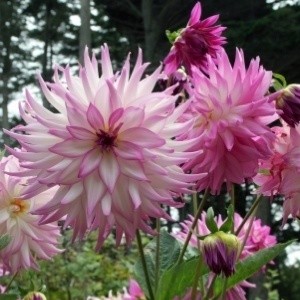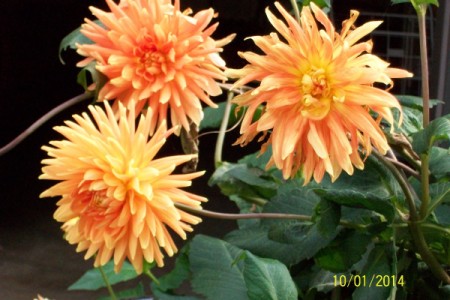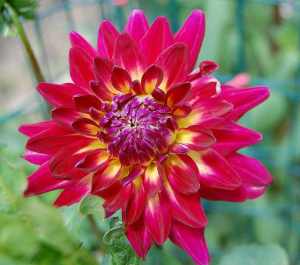 Dahlias are a great choice for both new and experienced gardeners alike. These tuberous perennials will grow in full to partial sun, in almost any soil, and are not usually favored by deer or rabbits. They are easy to grow, make wonderful cut flowers, and are a sensational way to bridge the late summer color gap - the period between the end of July until the first frosts of fall.
Dahlias are a great choice for both new and experienced gardeners alike. These tuberous perennials will grow in full to partial sun, in almost any soil, and are not usually favored by deer or rabbits. They are easy to grow, make wonderful cut flowers, and are a sensational way to bridge the late summer color gap - the period between the end of July until the first frosts of fall.
Dahlias can be grown from tubers, rooted cuttings, or seeds. They can be treated as annuals, or the tubers can be dug up in the fall for planting the next season. The easiest way to get started is to grow plants from tubers, which can be found at garden centers, nurseries, mail suppliers, or dahlia society sales. The hardest part is choosing which type of dahlia to plant. Dahlias come in a seemingly endless range of colors and forms. Plant heights can range from Lilliputian (1 foot tall), to tall (more than 4 feet), and flower sizes from miniature (less than 4 inches) to giant (the size of a dinner plate).
Site and Soil: The ideal site for dahlias will receive full sun and have a medium loam soil with good drainage and average fertility. If less than ideal conditions exist, don't worry. Gardeners will find dahlias accommodating to partial sun and most types of soil. (They also make great container plants.)
Planting Tubers: Dormant tubers can be planted in mid-April (warm zones) or early May (northern zones). Tubers can vary greatly in size, so dig a hole deep enough so that the crown (eye) of the tuber rests about 3 inches below the surface after planting. Place the tuber in the hole "eye" side up. Use your fingers to fill in the spaces around the tuber with soil. Finish by covering the hole with soil. Because tubers roots can be subject to rotting, they do not need to be watered in during planting.
Planting Rooted Cuttings: Plant in late May (warm zones) or early June (northern zones). Use a trowel to dig a hole slightly larger than the root ball of the cutting. Remove the cutting from its container, place it in the hole, and back fill the hole with remaining soil. Wait a day or so before watering.
Approximate Spacing:
One of the easiest mistakes to make with dahlias is to over feed them. If plants appear to lack vigor, use a slow release organic fertilizer that is low in nitrogen (e.g. 10-20-20). Apply it approximately 1 month after planting and again 4 weeks later. Fertilizers and soils containing high amounts of nitrogen, (including lots of compost), promote weak stems and small flowers.
Young dahlia plants need only occasional watering, as excessive moisture can promote root rot. As soon as buds appear, water plants once a week (unless it rains). Large varieties and dahlias planted under building eaves may need watering more frequently.
Dahlias have strong stems, but tall varieties (3 feet or more) and those with heavy flower heads usually require staking. Stakes should be inserted into the ground before tubers and cuttings are planted. If you are growing dahlias from seed, insert the stakes in the as soon as seedlings reach about 2-3 inches tall. Any type of support will work (wood, bamboo, tomato cages), as long as it is about 1 foot shorter than the expected height of the plant. The side of a building may also provide sufficient support for medium-tall varieties.
Dead-Heading: Removing faded blooms regularly will prolong flowering.
Pinching (topping): To encourage bushy plants with strong stems, pinch off center stems when plants reach 18-20 inches tall (about 3 weeks after planting).
Disbudding: To encourage larger (but fewer) flowers, remove the side flower buds, leaving only the terminal flower bud intact.
Unless you plan to enter your dahlias in a flower show, pests and diseases are usually not much of a problem. The worst pests, slugs, can be controlled with beer traps or by placing barriers made from crushed eggshells or diatomaceous Earth around the plants. Others, like aphids, red spider mites, caterpillars, earwigs, and cucumber beetles, can usually be controlled with organic methods like handpicking (earwigs, cucumber beetles, and caterpillars), spraying insecticidal soaps (spider mites and aphids), or with a strong jet of water from the garden hose.
After the foliage on your dahlias turns brown and dies back (about 2 weeks after a killing frost), cut the dead stems to about 6 inches and use a spade or fork to gently lift out the tubers. Rinse off excess soil and remove any broken or damaged roots. Lay the tubers out to dry on several sheets of newspaper for a day or two. After the tubers are dry, place them in boxes in between layers of peat moss or finely shredded leaves.
Store them in a cool, dark (frost-free) place. Each year your dahlias will continue to produce additional tubers. These can be divided to increase your stock or shared with others. Use a sharp knife to divide the tubers, keeping in mind that each tuber needs to have an "eye" in order to grow a new plant.
This page contains the following solutions.
Start with bare-rooted plants in the spring or sow seed indoors from four to six weeks before your last frost date. Seedlings should be pinched off when they are 4 to 6 inches tall to encourage bushier growth.
Here are the questions asked by community members. Read on to see the answers provided by the ThriftyFun community.
I bought way too many begonias and dahlias to plant this year. I'm wondering if anyone has a safe method of preserving them for the next season?

I store mine in a paper bag in my basement, or any cool and dry place. Plant in the fall.
I got some Dahlia bulbs. Any tips on how to plant them?
By AUDREY QUARTERMAIN from Edmonton, Canada
Search for "how to plant dahlia bulbs" lot of info there, good luck.
 I have a semi cactus dahlia "Tahiti Sunrise". What does pinching excess buds mean on this plant? I think that means only allowing 1-2 per stem, but am not certain.
I have a semi cactus dahlia "Tahiti Sunrise". What does pinching excess buds mean on this plant? I think that means only allowing 1-2 per stem, but am not certain.
By Wendy from Huntsville, AL
This is a page about dahlia photos. Dahlia blooms come in numerous colors and configurations.
At the end of the growing season, it is time to think about overwintering your dahlias. This is a page about wintering dahlias.
ThriftyFun is one of the longest running frugal living communities on the Internet. These are archives of older discussions.
I have always loved dahlias. I watched a program on tv, not too long ago about them, and really got sparked up again about wanting to learn more!